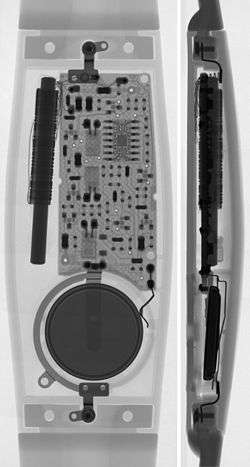Heart rate monitor

- This article refers to a device used by lay people. For the article on the medical device performing a similar function, see Electrocardiography.

A heart rate monitor is a personal monitoring device that allows one to measure one's heart rate in real time or record the heart rate for later study. It is largely used by performers of various types of physical exercise. In recent years, it has been common for smartwatches to include heart rate monitors, which has greatly increased popularity.[1]
History
Early models consisted of a monitoring box with a set of electrode leads which attached to the chest. The first wireless EKG heart rate monitor was invented in 1977 by Polar Electro as a training aid for the Finnish National Cross Country Ski team. As "intensity training" became a popular concept in athletic circles in the mid-80s, retail sales of wireless personal heart monitors started in 1983.[2]
Forms
Traditional heart rate monitors usually comprise two elements: a transmitter, worn on a chest strap, and a receiver. In early transmitters, water or liquid was required to get good conduction. In old versions, when a heart beat is detected a radio signal is transmitted, which the receiver uses to determine the current heart rate. This signal can be a simple radio pulse or a unique coded signal from the chest strap (such as Bluetooth, ANT, or other low-power radio link); the latter prevents one user's receiver from using signals from other nearby transmitters (known as cross-talk interference).
More recent devices use optics to measure heart rate by which measures changes in blood flow by shining a light from an LED through the skin and measuring how it scatters off blood vessels. In addition to measuring the heart rate, devices using this technology are able to measure blood oxygen saturation (SpO2). Newer devices include a microprocessor, which simultaneously monitors heart rate, oxygen saturation, and other parameters. These may include sensors such as accelerometers, gyroscopes, and GPS to detect speed, location and distance eliminating the need for ankle worn devices.
Accuracy
The newer, wrist based heart rate monitors have achieved almost identical levels of accuracy as their chest strap counterparts with independent tests showing up to 98% accuracy.[3]
See also
References
- ↑ "Smartwatch: Performance evaluation for long-term heart rate monitoring - IEEE Conference Publication". ieeexplore.ieee.org.
- ↑ Burke, E (ed) Precision Heart Rate Training
- ↑ Haskins, Tristan Chest Strap Vs Wrist Based HR Accuracy
External links
